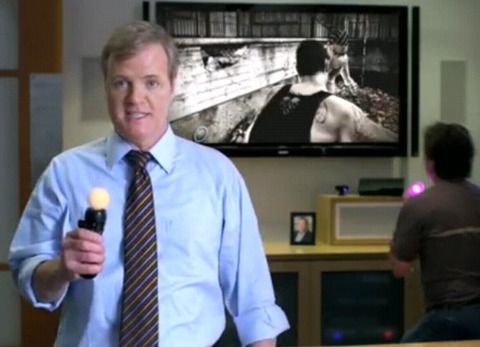PS Move shipments total 8.3 million
GDC Online 2011: Sony engineer recaps progress of Sony's motion controller, shows hypothetical Move-enabled Resistance 4 built on augmented reality technology.
Who was there: Gabe Ahn, developer support engineer for Sony Computer Entertainment America, delivered a sponsored session intended to bring developers up to speed on the basics of the PlayStation Move.

What they talked about: Ahn started with a stats dump, saying the Move has shipped more than 8.3 million units worldwide. (In April, Sony touted a total of 8 million units shipped.) As for software, Ahn said more than 7 million Move games have shipped in North America alone. There will be more than 80 games available by the end of 2011, and Ahn said SCEA expects continued growth through the remainder of the year. He thanked third-party publishers and name-checked EA, Activision, Capcom, Konami, as well as upcoming titles like BioShock Infinite and Ninja Gaiden 3 as examples of continued support for the peripheral in the future.
Ahn also stressed the diversity of games available for the Move, from hardcore shooters like Killzone 3 and MAG to more casual fare like EyePet.
While Ahn acknowledged the Nintendo Wii's success making motion control in games a ubiquitous feature, Ahn noted that Sony's forays into the field predated Nintendo's successful console. He pointed out that the EyeToy on PlayStation 2 has sold more than 10 million units and called the Move an evolution of that approach. He then showed a clip on "the future of gaming," which featured a Move player with a head-mounted display turning his world into an augmented reality version of Resistance, gunning down Chimera in a parking lot with his Move controller and sharpshooter setup. The clip was not entirely serious (the star first stuffed a PlayStation 3 into a backpack and was tethered to an outlet through an extension cord the entire time), but it pointed to the hypothetical potential of the interface.
"It could be Resistance 4," Ahn said. "It's a very cool concept."
There are four key requirements for a good game interface, he continued. They are: expressivity, precision, immediacy, and intuitiveness. Expressivity describes the richness of communication between the player and the game. Digital buttons are an example of one end of the spectrum because the player is either pushing a button or not. However, analog buttons, analog sticks, and cameras are increasingly expressive interfaces, although there are algorithmic limitations to current camera technology.
Precision is about the accuracy of the player's intent being translated into the game. It's a key requirement for deep games, Ahn said, as misinterpretation discourages players from playing games that demand precision. However, lack of precision can work well for party games with low demands.
Immediacy is another concern, as players would be put off by any latency or input lag. Unlike precision, there's little tolerance on immediacy for casual games, Ahn said, as immediacy enhances player immersion and connection to the experience. Finally, intuitiveness is arguably the biggest requirement for casual games, Ahn said. The interface should be obvious to the player, with as many abstractions as possible eliminated. The DualShock controller is particularly abstract, Ahn said, as pressing L2 to throw a grenade is a fairly arbitrary decision.
While each type of interface has different strengths, Ahn said the Move controller combines all of the desirable qualities of a good interface in one system. Even though some games are still best experienced with a DualShock controller (fighters for one), Ahn said the Move complements the traditional pad to enable new experiences even in familiar genres like first-person shooters. Calling the Move controller "the best offering for the current gen" when it comes to accurate 3D position and orientation tracking, Ahn said the Kinect was interesting but the lack of buttons hurt it.
Going beyond the PlayStation line of products, Ahn also touched on PC development tool Move.me, which allows academics and researchers to use the Move controller in their own projects, getting the same data from the controller that licensed developers get with official software developer kits. Currently, researchers are using the Move in attempts to improve math skills in students, improve rehab exercises for physical therapists, and more. The Move.me application was first released in July and is available from the PlayStation Network for $100.
Describing some potential ideas, Ahn showed off a clip of Johann Sebastian Joust, a Move dueling game set to the tempo of music. Players attempt to jostle each other's controllers by any means necessary (swatting, kicking, and the like) to eliminate them from the game, but they can only move as fast as the tempo of the game's music. Once a player's Move controller exceeds the allowed speed (whether by the holder's own motion or a rival's jostling), the sphere turns red and that player is eliminated from the game.
Ahn concluded his talk by promising that Sony is still working on future enhancements for the Move and peripherals that make sense to improve future game experiences.
Takeaway: The Move is a flexible piece of technology, and Sony isn't done trying to maximize its potential.
Got a news tip or want to contact us directly? Email news@gamespot.com
Join the conversation